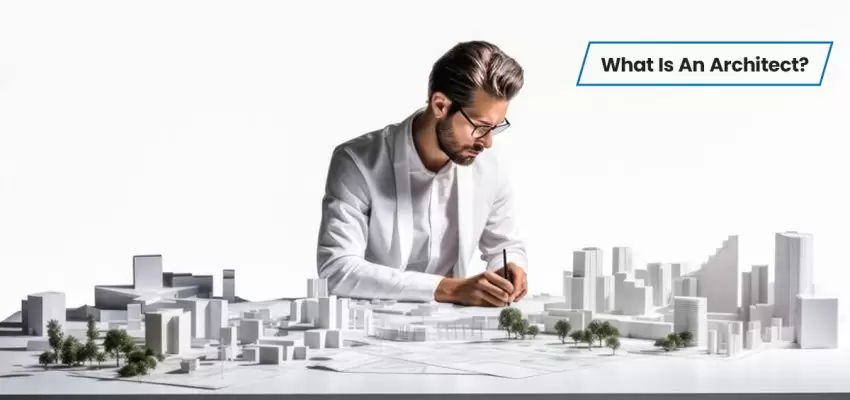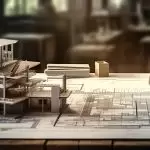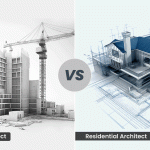Has it ever occurred to you that the most beautiful and innovative architectural wonders of the world were once someone’s imagination and their reality might told them that it is true fiction? That’s the beauty of the works of architects all over the world. The industry of architecture is way more than just construction, it is instead an expression of human creativity and ingenuity woven into the very fabric of our society.
Post your Requirement
Architecture is more than just construction; It is an expression of human creativity and ingenuity woven into the very fabric of our society. The aim of the industry is not just to create spaces that fulfil the practical needs of the clients but also to evoke a sense of emotion and inspiration that can stand the test of time. The architects are the professionals who serve as the designers of these creations, composing rhythms of form, function, and beauty to shape our world.
Who Are The Architects?
The architects are professionals who have received expert training on how to design, plan, and supervise the construction of diverse kinds of buildings are structures. With an attention to detail and the ability to work precisely to offer maximum efficiency, these are the professionals who have a specialization in the art and science of building structures. They play a significant role in shaping the built environment, from residential homes and commercial buildings to public spaces and urban landscapes.
The architects work closely with different clients to have a deep understanding of their needs and requirements, creatively visualize what their clients want from a building project, create designs, and bring that vision to reality to ensure the creation of highly functional, aesthetically pleasing, and sustainable solutions that meet the quality, technical and regulatory standards of the government.
What Do Architects Do In Core?
In core, an architect refers to a kind of professional which means someone responsible for the architectural design of structures or buildings. This is true that architects design buildings, but their job description involves responsibility for much more than just the artistic elements of designs. Some of the key responsibilities of the architects include the following:
- Understanding Client’s Needs: The architects work closely with the clients to understand their functional and aesthetic needs and preferences along with the budget of the client. They analyze a wide range of factors such as site conditions, zoning regulations, building codes, environmental considerations, and others, and then build many design concepts and proposals that reflect the objectives and vision of the client.
- Design Building: The architects must translate the conceptual designs into detailed architectural drawings, plans, and specifications to build spaces that can meet the project goals and client needs. They also use specialized tools such as CAD for creating 3D models and draft techniques for the creation of floor plans, elevations, sections, and other architectural documents that can present the design intent and technical specifications to clients in detail.
- Technical And Regulatory Compliance: The architects are the professionals who need to be aware of the local building codes and the regulatory and safety standards of the government. Thus this comes under the scope of work of the architects to ensure that the designs meet all technical and regulatory requirements and prevent any future legal concerns. They adhere to the zoning laws, structural integrity, fire safety, and accessibility requirements of the project.
- Project Management: The professionals supervise and oversee the different aspects of the project from concept to completion. They work and coordinate with other construction professionals such as engineers, consultants, contractors, interior designers, builders, and other professionals to ensure that every task is executed according to the pre-defined schedule, budget, and quality standards. They conduct site visits, review progress, manage potential contingencies, manage if any issues arise, and ensure that the project is done with perfection.
- Construction Supervision: They also offer on-site support and supervision during the construction phases of the project. They review the progress of construction, assess workmanship, and address if there are any issues or changes in the project. The professionals also respond to different requests for information (RFIs), review shop drawings, and approve material selections for the project. Additionally, they also prepare and submit permit applications, coordinate with regulatory authorities, and obtain necessary approvals to proceed with construction projects legally and safely.
- Focus On Sustainability: In the modern era, with the rising inclination of people towards the idea of care for the environment and environmental sustainability, architects are also incorporating environment-friendly practices in their operations. With a strong emphasis on the use of natural materials, energy-efficient systems, green structures, and smart sustainable techniques, the architects are now considering the new trends in environmental protection.
Exploring Common Architect Types To Choose The Right Professional
The architects are the professionals who are behind the different buildings and structures we see around us every day. They may have different personalities, thought processes, and ideas but a key feature of all of them is that they wish to make a difference in the world with their designs.
There are different kinds of architects with their own set of specializations and fields of expertise that make them unique in their operations and qualities. Some might focus on interior architecture and some might on landscape designs or industrial designs, so let’s explore some of the unique architect types to make an informed decision for your project.
- Interior Architects: First I would like to clarify that interior architects are not the same as interior designers. They have a whole other scope of work in the industry. Interior architects are licensed and accredited architects who have superior expertise in the planning of the interior rooms of buildings, including the location of walls, windows, and doors. Along with a strong understanding of interior design, they also have the technical know-how of the different building methods and techniques. They manage both the décor of the space and the planning of the structural components to plan how that design will take shape and form.
- Landscape Architects: As the name suggests, landscape architects are professionals who possess a strong specialization in the design, planning, and development of different kinds of outdoor spaces including private, and public gardens, lawns, parks, orchards, building walkways, squares, and others. They typically possess a deep understanding of horticulture and how to coordinate different kinds of natural materials with certain buildings, roads, or structures in the environment.
- Residential Architects: Designing a beautiful and functional home is often considered a basic architectural task but it can be surprisingly complex when you get to work. In the present era, the cookie cutter homes have become more common due to the practicality and affordability they offer and this has resulted in making residential architecture a less prestigious option. At the core, residential architects are the professionals who work collaboratively with homeowners, builders, and developers to create appealing, functional homes, apartments, or other residential spaces.
- Resort Architects: They are another kind of architect professional working to enhance the commercial landscape of the country. As the name suggests, resort architects are professionals who work to create comfortable and immersive environments for luxurious hotels, resorts, and other recreational spaces. With an emphasis on creativity and functionality, they create spaces that offer a blend of architecture and the hospitality industry.
- Retail Architects: The shopping complexes, malls, and other retail spaces are more about experience and ambience than about superiority in design. Retail architects are the professionals who create these tempting experiences by designing stores, shopping malls, and commercial retail spaces that excel at functionality, aesthetic appeal, and innovation. They create spaces that reflect the personality of the owner with their superior expertise in branding, display design, and traffic flow optimization for the brands.
- Building Architects: The building architects are the professionals who design, plan, and build the different elements of the buildings. They have a specialization to work in a variety of settings such as government sectors, public organizations, and private firms and create highly functional spaces. They usually oversee the construction of structures like public dwellings, complexes, educational and manufacturing facilities, and even commercial plazas that serve varied applications.
- Commercial Architects: There are a kind of students who dream of planning and building high-rise buildings that will define a city’s skyline or create a new tourist attraction that will be on social media for generations. This is what commercial architecture is all about. Commercial architects are professionals who have superior expertise in the design, planning, and building of projects such as office towers, retail shops, museums, hotels, public buildings, government centres, and other kinds of non-residential properties serving diverse commercial purposes.
- Hospital Architects: The environments of the hospital need to be hygienic, functional, and conducive to the comfort, care, and recovery of the patients. Professional hospital architects are experts who have superior specialization in the planning and development of these environments of clinics, hospitals, and other wellness centres. They have a strong understanding of healthcare regulations, what layouts would be efficient for the space, and how to create patient-focused designs to create emergency facilities, medical centres, research centres, and other relevant structures.
- Industrial Architects: Industrial architects are professionals who have expertise in the development of spaces where functionality and practicality are the top priority. They typically create spaces for industrial use such as factories, warehouses, storage buildings, distribution, logistics facilities, industrial parks, power plants, transport hubs, and, others. They understand the client’s needs and integrate the different processes, machinery, and, equipment of a specific industry to create a functional building design.
Different Stages Of The Architectural Process
The development of a structure or a building is done in several stages. Understanding the different stages of the architectural process and their key deliverable at every stage is crucial for the proper management of your expectations from the project. This includes everything from concept to completion, so let’s dive deeper into what architects do at every stage of the process to have a clear roadmap of the work of the professionals at each stage.
1. Pre-Design Phase
Also known as the programming phase, this refers to the first stage of the process that marks the beginning of the project. This is the phase where the respective architect sits with the clients to have a glimpse into the plot of land, any existing structures in the space, and the expectations and requirements of the client for the structures. They execute an in-person analysis of the site and are aware of the relevant building and environmental regulations along with the local zoning and land-use restrictions, and develop a project brief or program outlining specific requirements and priorities. The key deliverables for this phase of the project are as follows:
- Project Brief.
- Initial budget estimates.
- Feasibility studies.
2. Schematic Design Phase
This is the phase where the architects develop the different design options that can be reviewed, modified, and refined. They present their understanding of the vision and needs of the clients and develop drawings, sketches, 3D renderings, floor plans, preliminary site plans, and building elevations along with HVAC and plumbing systems. In this phase, the professional architects explore the different layouts for the projects and create spatial relationships and designs with superior aesthetics. They value customer feedback and give them options to help them get their dreamy design and structure. The key deliverables for this stage include the following:
- Concept drawings (plans, sections, elevations).
- Rough cost estimate.
- Preliminary 3D visualizations or models.
3. Design Development Phase
This is the phase where the schematic design is refined to offer better results to the clients. This is the phase where the design intent of the architect is manifested as a detailed plan to ensure that the plan is made to ensure maximum client satisfaction. Here the details of materials, systems, structural elements, and other structures are finalized and decided. If the project requires the expertise of a structural or mechanical engineer, this is the stage where the professionals are hired. The architects consult with different professionals and also ensure that the different structures of the project meet the regulatory and quality standards of the government. The key deliverables at this phase include the following:
- Detailed drawings and plans.
- Updated cost estimates.
- Refined 3D models or renderings.
4. Construction Document Phase
This phase is facilitated by the creation of finalized drawings and specifications that convey the functional, aesthetic, and performative intent of the project. This is the phase where the design that was just on a piece of paper becomes a reality. Here the architects create two sets of detailed drawings that specify every detail of their final design and they are used to ensure everything goes as planned. One of these sets is the construction set which remains on-site throughout the construction process and the other is called the permit set which is sent to the local permitting authorities for a city or even a country. The architects prepare detailed documents and provide proper information on contractor bidding and permits. The key deliverables of this phase include the following:
- Construction-ready drawings.
- Specifications manual.
- Finalized cost estimate.
5. Bidding And Negotiation Phase
This is the phase where the architect has to submit the permit set of drawings as part of a larger permit application to the regulatory organizations. The city or country reviews these submittals considering the structural integrity of the project and its adherence to zoning laws and building codes of the government. In this phase, you get a finalized set of contract documents and thus this phase is facilitated by hiring a contractor. If the project is design-build and the design and construction are managed by the same firm, there is no need to raise bids from construction contractors. But in the other case, the architect and the clients need to interview the contractors, solicit competitive bids, clarify designs, compare bids, negotiate costs, and other relevant aspects. Some of the key elements of this phase of the construction project include the following:
- Selected contractor.
- Construction contract.
6. Construction Administration Phase
This is the phase where the role of the architects shifts from designing or planning to managing the whole project to build smart and functional structures and spaces. This is the phase where the contractors lead the construction process and the architects make regular visits to the construction site to ensure that everything is executed as per plans. The architects maintain clear communication with the other contractors and sub-contractors to ensure that the design intent is fulfilled with the best efforts. The architects also review different aspects, analyze submittals, address design changes, and unforeseen issues, and assess change orders and payment requests to ensure the best work within budget limits. The key deliverables of this stage of the work include the following:
- Site inspection reports.
- Approved submittals.
- Final punch list (list of items to be completed or corrected)
7. Post-Construction Phase
This is the phase where ribbons are cut and doors are opened as the work is completed. This is the final stage where the project is wrapped up and then reviewed to offer maximum satisfaction to the client. In this stage, the final inspections are conducted by the professionals, and the work is approved if everything is up to the mark. The architects also offer as-built drawings and the necessary documentation for clients’ long-term peace. Additionally, this is the [phase where your professionals will answer your questions especially the ones related to maintenance and operations. They also perform evaluations and address different potential warranty issues to enhance the customer experience. The key deliverables at this phase of the architectural process are as follows:
- Occupancy permits.
- Maintenance manuals.
- Post-occupancy evaluation.
Choose The Right Architects To Build Your Dream Project With Excellence
People often consider that consulting an architect is a huge investment and they can plan their home or office by themselves as they know their own needs and expectations. Not to break your bubble, but this is a huge mistake. It will lead to a plethora of issues or problems which will result in extra overrun costs thereby increasing the final costs and you won’t even get the perfect space.
So for the technical, comprehensive, and complex work of architecture, it is often a critical need to hire a professional and seek their services. This will protect you from the headache of work, the stress of managing everything, the struggle of finding the right vendors and professionals, and whatnot. It is often the right thing to do to have a brief understanding of different kinds of architects, their scope of work, and their expertise to make an informed decision and build your space with perfection.
Read Also: Top Tips For Hiring Architect And Different Types Of Architects























Post A Comment